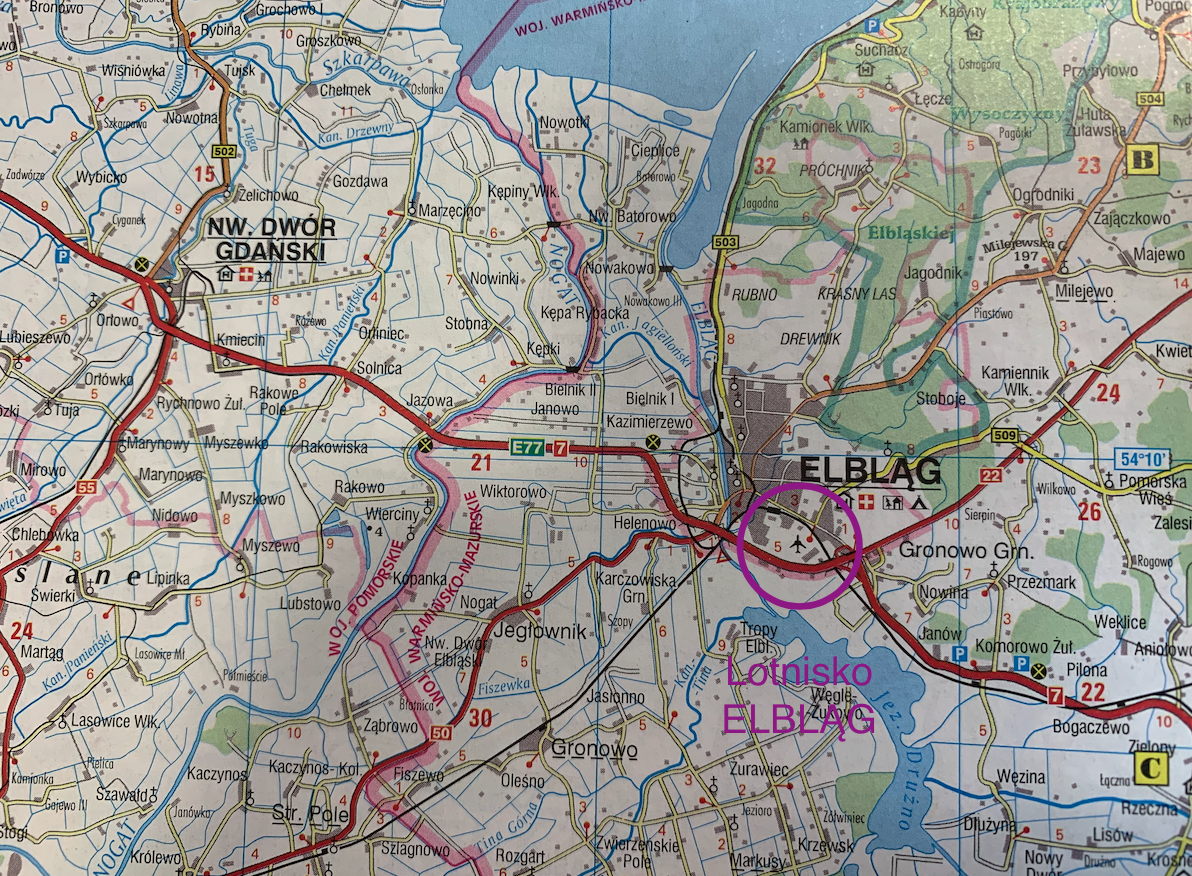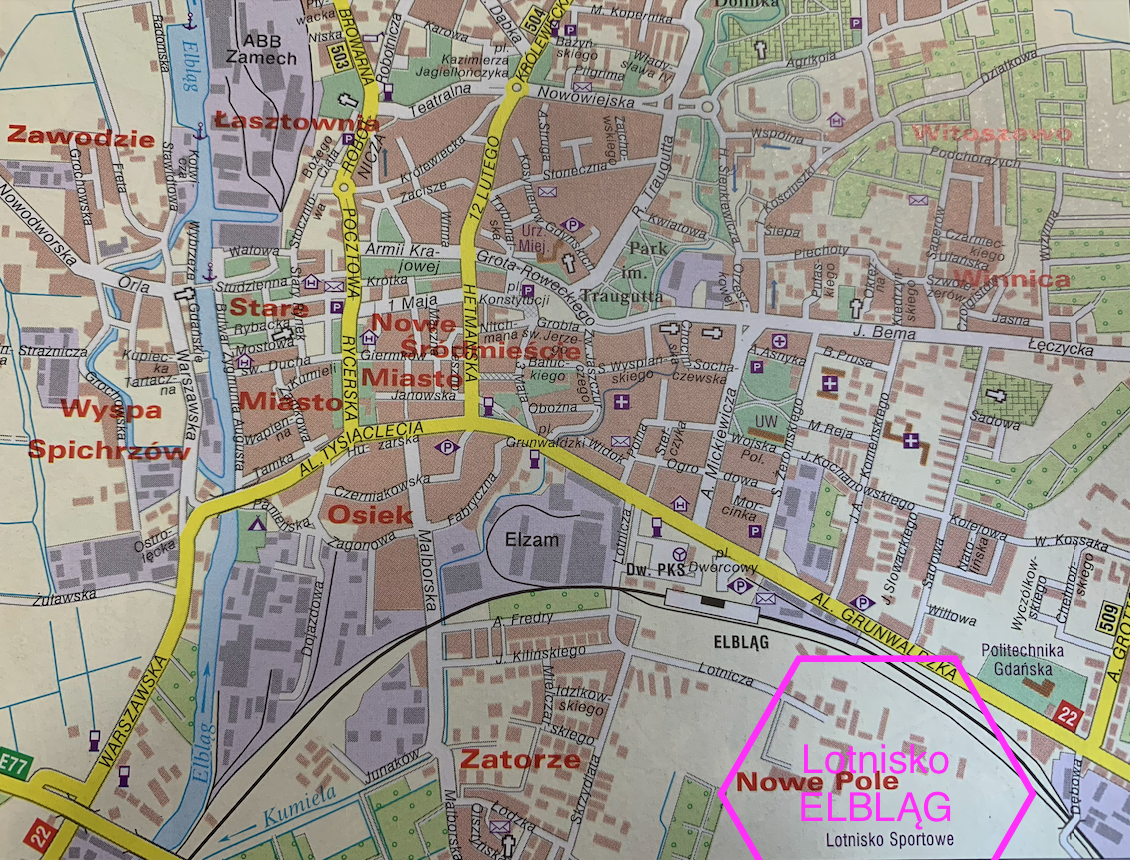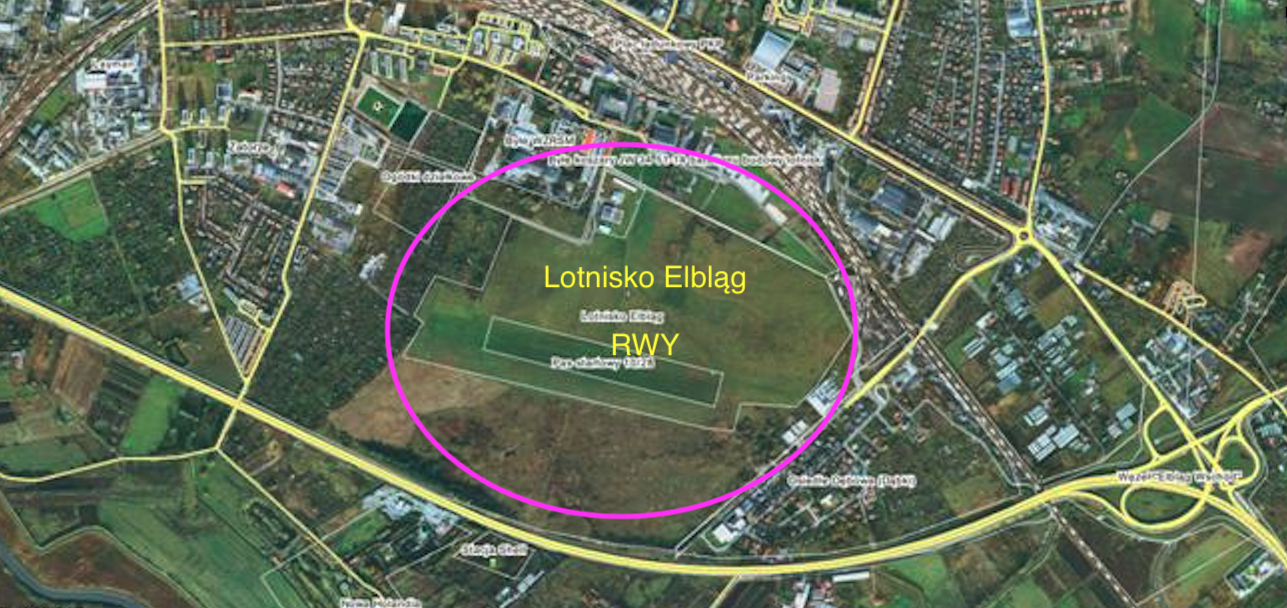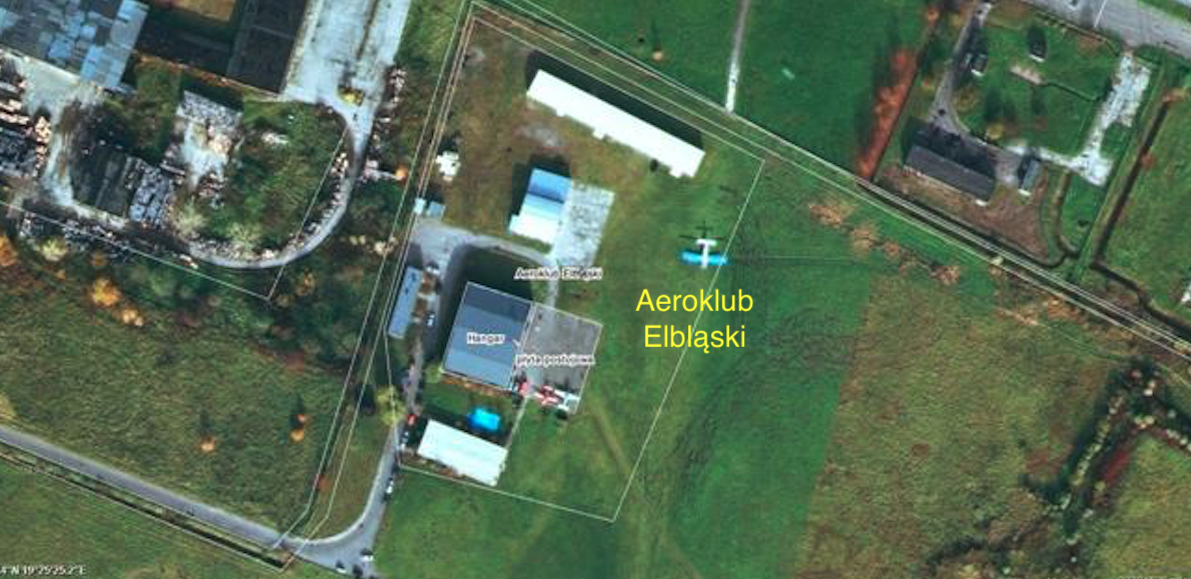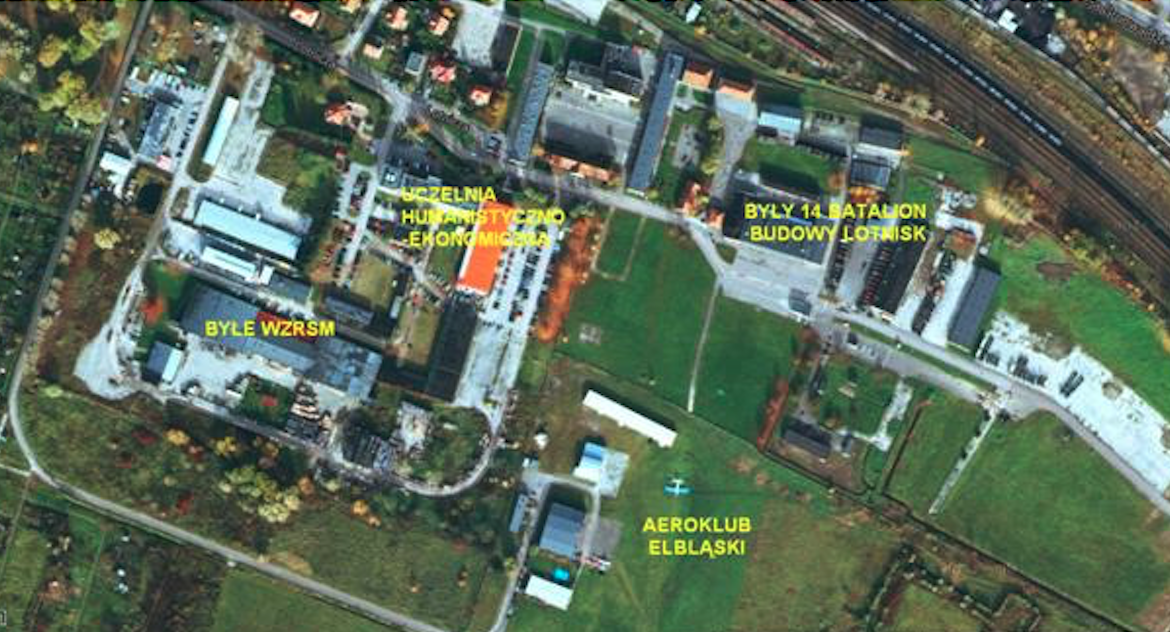Elbląg 2013-12-05
Airport in Elbląg.
Geographic coordinates: 54.142N 19.423E. Geographical coordinates; N54 ° 08’27.2 "E19 ° 25’24.1". Situated at an altitude of 3 m (10 ft) above sea level.
History of the City of Elbląg.
Elbląg (Latin name Elbinga, Prussian name Elbings). The city has poviat rights and is located in the Warmian-Masurian Voivodeship. It is one of the oldest cities in Poland. It is situated at the mouth of the Elbląg River to the Vistula Lagoon. According to data from June 30, 2012, 123,977 inhabitants lived here.
The city was founded in 1237 by the Teutonic Knights (closer to the Vistula Lagoon), but almost immediately it was destroyed by the Prussian tribes of Pogozean. The Teutonic Knights moved to today’s Old Town, where a settlement had existed since the 10th century. In 1246, the settlement was granted city rights. From 1250, the Teutonic Knights began to rule here. The Teutonic Knights brought Germanic settlers here. In the following decades, the Teutonic Knights conquered the Prussians, murdering them to the last.
Thanks to its location, Elbląg was a seaport for the Teutonic Order. Around 1300, a brick castle was built here, which, next to the castle in Malbork, was the most important in the lands of the bloody order. The basis for the development of the city was maritime trade, which resulted in the influx of not only goods, but also settlers and robbers from various countries. The city of Elbląg participated in the life of the Hanseatic League. From the mid-fourteenth century, Elbląg began to gradually lose its importance in relation to other Prussian port cities. After the murder of the Prussians, Elbląg ceased to be a military base to the east, and after the Teutonic Knights seized Gdańsk Pomerania and the establishment of the capital of the Teutonic state in Malbork, Elbląg lost its character as the main political and economic center. After the defeat of the Teutonic Knights with the Polish-Lithuanian army at Grunwald in 1410, the townspeople of Elbląg conquered and drove out the Teutonic Knights together with a large hospital and the local commander. On July 22, 1410, the inhabitants of Elbląg paid homage to the Polish King Władysław Jagiełło. However, in September 1410, the castle returned to the hands of the Teutonic Knights. In 1440, it was in Elbląg that the Prussian Union was established. On February 12, 1454, as a result of the anti-Teutonic uprising, the townspeople from Elbląg, after a 5-day siege, captured the Teutonic castle, and then, fearing that the Teutonic Knights would return again, destroyed it. In the same year, the inhabitants of Elbląg paid tribute to King Casimir IV Jagiellon in the captured Teutonic castle. In 1454, Elbląg received a great privilege from the Polish King Kazimierz Jagiellończyk, confirming the old laws, extending the power of the Polish self-government, increasing the powers of the City Court and enlarging the city’s territory almost twice. The city of Elbląg took over the existing fishing rights of the commanders, their mills and other goods. In return, Elbląg actively participated in the defeat of the Teutonic fleet in sea battles in the Vistula Lagoon. According to the provisions of the Peace of Toruń ending the Thirteen Years’ War in 1466, Elbląg was granted to Poland, to which it belonged for about 300 years, until 1772, i.e. until the partitions. The golden sixteenth and seventeenth centuries came to Elbląg. The turn of the 16th / 17th century was a period of development of the city and sea trade, caused by the war of Stefan Batory with the rebellious Gdańsk. At that time, all Polish exports and imports went through the port in Elbląg, until the king’s agreement with the townspeople of Gdańsk. As a result of the Polish-Swedish war over the mouth of the Vistula, in the period 1626-1635 a Swedish garrison was stationed in the city, which withdrew from the city after signing the truce in Sztumska Wieś. During the Deluge, the Swedish army captured the city on December 22, 1655. The destruction caused by the Swedish occupation in the period 1656-1660 stopped development, and the plagues that accompanied it depopulated the city. During the Great Northern War, the city was occupied successively by Swedish (1703-1710), Moskal (1710-1712) and Saxon (1712) troops. Successive stays of foreign troops depleted the municipal budget. The fallen city became easy prey for Prussia. Already during the First Partition of Poland in 1772, Elbląg was under Prussian rule. The city lost all its privileges. The city authorities were subordinated to Prussian state officials. Elbląg became a provincial district town. Striving to make Poland economically dependent on Prussia, the invader imposed a tariff on Polish goods. At the beginning of the 19th century, the city was relegated to the role of a river port in local trade. Against this background, the metal, weaving, dyeing and glass industries began to develop. Numerous agri-food processing plants, tobacco plants, soap factories, oil mills and starch plants were established. The shipbuilding industry has not disappeared. Economic development brought with it the formation of a working class, the core of which were metal workers. This is how the seeds of Germanic communists were born, who drew their knowledge from Red Moscow and Red Berlin. Cells of the Social Democratic Party of Germany started operating in the city. With the outbreak of the Great World War, the city’s situation deteriorated significantly. As early as 1914, tens of thousands of refugees visited Elbląg. The result was widespread chaos, lack of food, etc. The economic downturn of the war years resulted in the closure of many industrial plants and, as a result, increasing unemployment. In the final years of the war, thousands of inhabitants suffered from hunger and there was a shortage of housing.
After the Gemańcy lost the war, as a result of the provisions of the Treaty of Versailles of 1919, from November 28, 1920, Elbląg, along with the eastern part of West Prussia, remained in Germanania. The loss of natural outlets led the industry in Elbląg to another crisis. Communist movements continued to develop. Workers’ councils and other revolutionary organizations operated here, including the German communist party. After Hitler’s bandit came to power, Elbląg became a garrison center. A military aviation school was established at the airport, which had already been established during the World War II. Barracks for artillery, cavalry, engineering and infantry were built in various parts of the city.
At the beginning of World War II, armored columns were launched from Elbląg for the invasion of the Republic of Poland. Camps for people displaced from Germanania to the territories of the eastern Polish Republic were established here. POW camps were established here. There were two sub-camps of the Stutthof concentration camp. The Muscovites fought for Elbląg from January 23, 1945 to February 10, 1945. Fierce battles left the city in ruins. The historic buildings of the Old Town were destroyed, as well as the entire Śródmieście. It is estimated that about 10,000 soldiers and civilians died during the fighting. During the reign of Moslems, the city was plundered of all machinery and factory equipment.
On May 19, 1945, that is, nearly three weeks after the end of World War II, the Muscovites officially handed over the keys to the city to the communist Polish authorities. Importantly, some Soviet military units remained in Elbląg for a few more months. After more than 170 years, Elbląg was again within the borders of the Polish State. The new authorities’ priority was to give the city a Polish national identity and to deport the Germanic population. Brick from the ruins of Elbląg was sent to Warsaw for its reconstruction. Elbląg Old Town has been completely demolished.
The case of Elbląg.
In 1949, the city of Elbląg was affected by Stalinist terror in events known as the Elbląg Affair. It is worth mentioning.
The Elbląg case is a colloquial term for the events related to the fire of the production hall No. 20 of the Zamech mechanical plant in Elbląg and the consequences of this fire. On the night of July 16-17, 1949, the production hall No. 20 of the Zamech mechanical plant in Elbląg burned down. After the fire, the Security Office arrested over 100 people on charges of sabotage. Some of the arrested had no connection with the Zamech, their arrest was political, including the re-emigrants from France accused of forming a spy network. Three of those arrested were sentenced to death, six to long-term imprisonment. Many people died during or shortly after the investigation. It was the most felt act of communist-Stalinist terror in Elbląg. This event is associated with the ongoing campaign against Poles living in France during World War II, as well as French citizens and diplomats staying in Poland at that time. Sentenced to death: Jean Bastard, Alojzy Janasiewicz, Andrzej Skrzesiński.
Sentenced to imprisonment: Stefan Czyż (life imprisonment), Adam Basista (15), Bolesław Jagodziński (15), Bolesław Bobulis (12), Edward Dawidowicz (12), Józef Olejniczak (11). Died during the investigation: Henryk Zając (found dead in his cell).
In 1956, all convicts were acquitted. This event is commemorated in Elbląg with a square named after the Victims of the Elbląg Case and a commemorative plaque. An acquittal and a memorial plaque are not enough. Not only should communist criminals be exposed, but they should also be tried and punished. The lack of vetting and decommunization after 1989 gave a safe conduct to the communists, whose sons and daughters still play important functions in the state apparatus of the Republic of Poland.
In the 1980s, the construction of the city center began, however following the communist pattern. Work on the foundations revealed the foundations of old buildings. A side issue was that Elbląg obtained valuable information about its history.
Elbląg still has a chance of becoming one of the most important cities in Poland. However, the first step must be to gain access to the Baltic Sea through the Vistula Spit and build a new airport. The Vistula Spit cut became a reality in 2022. Currently (2022), the navigable canal to the port is being modernized.
History of the airport in Elbląg.
In 1912, the Germanic Stiefvater, flying by plane from Berlin to Królewiec via the coastal air route, was forced to make an emergency landing on one of the streets of the City of Elbląg. The aviation history of Elbląg dates from this event, the 100th anniversary of which was solemnly celebrated in 2012. The airport was built for the needs of the Great World War in 1915. Its intensive expansion and militarization took place after Hitler came to power in Germany. The Germans were very proud that Hitler visited their airport and town three times. The airport was named Fliegerhorst in May 1939. The airport served connections with Królewiec, Szczecin and Berlin. From 1935, military pilots were trained here and a bomb regiment was stationed, and temporarily also a fighter regiment. In the summer of 1939, a large ammunition and bomb depot was set up in the southern part of the airport. On August 30, 1939, about 200 bomber and fighter planes were based at the airport. The bomb regiment from September 1, 1939, participated in the bombing of Polish cities: Tczew, Grudziądz, Toruń and Bydgoszcz. Their first destination was the bridge over the Vistula River near Tczew. The Germans reportedly did not want to destroy the bridge, but to keep it. They attributed the destruction of the bridge to Polish sappers. Nay. The Germanic plague is proud that the attack on the bridge over the Vistula River was carried out at 04:34, that is before the official declaration of war on Poland.
During World War II, there was a lot of traffic at the airport in Elbląg. There was an aviation school. Many barracks were erected as accommodation and warehouses. The construction of drainage ditches for drainage of adjacent areas has started.
In October 1943, about 100 American bombers flew over Elbląg. Their destination was the airport and factory in Königsdorf, near Malbork. There, the planes dropped bombs on the Messerschmitt assembly plants and completely destroyed them. All workers were hired to repair the damage. When everything was rebuilt in April 1944, the bombers flew in again and turned everything into disrepair.
After World War II, the airport fell into the hands of Moskal. Various Soviet regiments were temporarily stationed here. In 1948, the Muscovites handed over the airport to the Polish Army. From 1948 to 1952, the 5th Assault Aviation Regiment was stationed at the airport, which was then transferred to Bydgoszcz and stationed there for many years. The 5th Assault Aviation Regiment was not the only air unit in Elbląg. On the basis of the order No. 0096 / Org. Minister of National Defense on December 11, 1951, the 50th Assault Aviation Regiment was formed. The unit was organized in the Elbląg garrison, at the Elbląg airport. The first order of the commander of the 50th PLSz was issued on May 1, 1952. The unit was formed according to the number of employees No. 6/104 with a capacity of 307 soldiers and 2 contract workers. The unit received JW No. The 4697th Regiment was part of the 13th Assault Aviation Division. However, on November 19, 1952, order No. 0078 / Org. Of the Minister of National Defense, who ordered the 50th Assault Aviation Regiment to be disbanded by December 20, 1952.
The main problem with the airport was the lack of a hard runway. Due to its location, the airport was not attractive in the plans of the Polish Army. The airport, as a passenger one, could not develop due to the poverty of Poland. In addition, during the times of the Polish People’s Republic, the authorities in Warsaw did not notice that Elbląg was within the borders of Poland. In 1957, the airport became the seat of the Elbląg Aeroclub.
You should also know that due to the wet meadows nearby, fog often rises above the airport. The take-off field itself is exceptionally soft.
On June 6, 1999, the June service was celebrated on the field of flights by the Holy Pope John Paul II, who visited Elbląg during his 7th pilgrimage to Poland. Here, to welcome the Pilgrim of Peace and on the occasion of the upcoming Great Jubilee of the Year 2000, the Racing Pigeon Breeders Association released 2,000 pigeons, which soared over the altar and over the gathered people. During his stay in Elbląg, the Pope celebrated a service in honor of the Sacred Heart of Jesus. It coincided with the anniversary of the consecration of all mankind to the Heart of Christ by Pope Leo XIII. In his homily, John Paul II referred to the martyrdom of St. Wojciech, who died in the nearby Święt Gaj. – You have to be faithful to the end, (…) you have to have the courage to protect the image of God in your soul, even at the highest cost – the Pope said.
The visit of Pope John Paul II to Elbląg was a one-off, but extremely important event in the history of the city. It is alive in the minds of the participants of the papal liturgy. Remains in the city of mementoes of the presence of Saint John Paul II in it: the monument at the cathedral of St. Nicholas, the throne and kneeler in the cathedral temple, the chalice – a gift from the Holy Father, the papal cross in Traugutt Park and the cross on the building of the Higher Theological Seminary, hospital and school bearing the name of the Pope, tunnel in Elbląg railway station and street named after John Paul II. In the Archives of the Diocese of Elbląg, rich archival documentation related to the preparation and course of the papal visit has been collected and cataloged.
On July 14, 2012, on the occasion of the 100th anniversary of Elbląg Airport, an air festival was organized. At the same time, it was the International Rally of Aviation Enthusiasts. On the part of the Polish Army, "White-Red Sparks" and helicopters of the Navy and Border Guard appeared. The Polish Aviation Museum in Krakow actively participated in the event. There was the "Żelazny" group and balloons. Modelers with flying and reduction models also showed up. The main organizer of the shows was the Aeroklub Elbląski.
The "Multiannual Investment Plan until 2020 for the city of Elbląg" provides for the expansion of the current sports airport and adaptation to the applicable standards for the needs of civil aviation in the years 2016-2020.
Polish Army in Elbląg.
During the times of the Polish People’s Republic, Elbląg became a large military garrison. Not only air units were stationed here (which in fact were an episode here), but most of all armored forces. Eight large military units were stationed here; 16th Infantry Division (transformed into the 16th Kashubian Armored Division), 1st Medium Tank Regiment, 4th Pomeranian Heavy Tank Regiment, 55th Elbląg Mechanized Infantry Regiment, 58th Medium Tank Regiment, 60th Kartuski Medium Tank Regiment, 13th Medium Tank Regiment Armored Artillery, Mechanized Infantry Officer School.
We have already mentioned air units above. But there was one more unit in Elbląg, strongly associated with military aviation; 14. Airport Construction Battalion. Formed in Oleśnica on October 15, 1952, on the basis of the order No. 0552 of the Minister of National Defense. At the beginning of 1954, the battalion was transferred to Elbląg and stationed here until disbanded in 2010. In its history, from 01/01/2000, it was renamed the 14th Airfield Damage Removal Battalion (14 buzl), and from 01/01/2009, as the 14th Airport Renovation Battalion (14th Brl). The unit was subordinate to the commander of the 2nd Air Defense Corps in Bydgoszcz, and then the commander of the 1st Tactical Aviation Wing in Świdwin. The unit was called JW. 3451 and stationed near the Elbląg Airport. On December 31, 2010, the battalion was disbanded.
The area of the unit covers 19 hectares with several buildings, including former barracks. The Polish Army handed over this facility to the Military Housing Agency, and then to the city. The property was valued at 11 million 700 thousand. zlotys. The city authorities wanted to allocate the area of the military unit for investment. Ultimately, the city became the owner of this area for PLN 5 million.
Airport infrastructure.
The infrastructure around the airport in the so-called Zatorze was very rich. A few objects come from the Germanic times, but most of them were built in the times of the Polish People’s Republic. Three large hangars were built here. Until now, one is used by the aeroclub, which has built another, smaller hangar. The two remaining hangars were used for many years by the wax repair workshops, and then by the Allmet production plant. The northern part of the complex, along with the barracks and staff parts, was occupied by the 14th Airport Construction Battalion.
Elbląg airport.
Elbląg airport (IATA code: ZBG, ICAO code: EPEL) – a grassy airport located in Elbląg at Lotnicza 8. The airport is managed by the Elbląg Aeroclub. The airport is located almost within the administrative boundaries of the city of Elbląg, in the so-called Nowy Pole. The term Zatorze is also often heard. Address: ul. Lotnicza 8b 82-300 Elbląg.
A grassy field of highs. Possible DS .; RWY 08/26 900 m x 200m, RWY 03/21 600 m x 300 m, RWY basic 10/28 (104/284) 600 m x 200 m, RWY acc. To AIP closed 07/25 (075/255) 913 m x 100 m. Radio ; Port / Info – PORT 122,300 MHz, Square / Aero – AERO 122,100 MHz. Contact +48 537 334 410 or +48 601 638 917. www.aeroklubelblaski.pl. The airport has an area (about 50 hectares) and it is practically impossible to expand in terms of area.
Navigation info; Powered Aircraft – South Circle. Gliders – Northern Circle. Mandatory two-way radio communication in ATZ EPEL. Operating hours: MON-FRI 08: 00-16: 00 LMT.
The Elbląg Aeroclub offers an airplane hangar at the airport for rent. The access to the hangar is cleared of snow in winter. 24h security. The hangar is insured. Electrically opening doors. Approximate rental costs from PLN 550 gross per month. The aeroclub conducts gliding and flight training. The Elbląg Aeroclub also runs a parachute section. The aeroclub has an An-2 plane, so it takes many jumpers into the air at once. The parachute section conducts training for the landing line on MARS parachutes. For adventurous people, tandem parachute jumps are organized from a height of up to 3,000 m. Cost from 700 PLN.
How to get to the Elbląg Airport? You need to enter the city center near the train station and find yourself on Aleja Grunwaldzka street. It is a through Elbląg Street and at the same time Provincial Road No. 500. You should turn into Lotnicza Street towards the south. After crossing the railway crossing, follow the main road to the left (east). This is still Lotnicza Street. Theoretically, we should go straight to the airport. But, after about 200 meters there is a sign that directs us to the asphalt block to the right and it brings us to the airport. Exact address: ul. Lotnicza 8b, 82-300 Elbląg.
Written by Karol Placha Hetman

